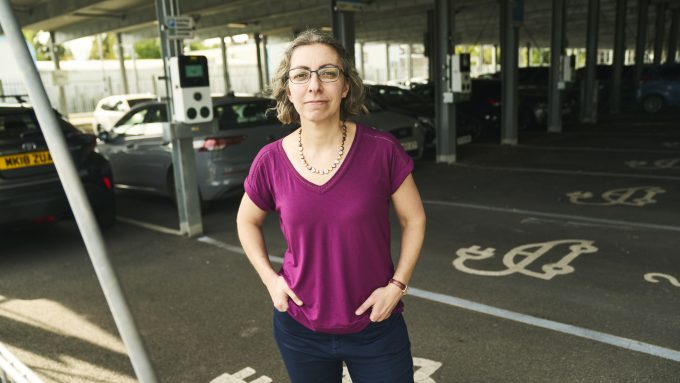
National Highways: the need for innovation has never been greater

Small-to medium-sized companies (SMEs) with innovative technologies are starting to play a larger role in the minds of major contractors delivering projects on England’s strategic road network, an event convened by National Highways and Connected Places Catapult has heard.
Five tier one suppliers involved in two National Highways accelerator programmes described their recent experiences of working with seven SMEs – supported by the Catapult to trial new products or processes – at an Innovation Showcase event at the Barbican in London.
The two accelerator programmes cover improving the customer experiences of roadworks, and the development of low carbon materials.
Among the tier one suppliers to host live trials on motorways and major A roads is Costain, whose Highways Customer Lead, Richard Paddey remarked: “We wanted SMEs to come forward with new concepts and innovations – and that’s exactly what they did.”
The initiatives on show, he added, demonstrated the “power of getting together and talking about issues we face in the industry” while also providing “a perfect platform for tier ones to explore new opportunities with innovators who want to make a difference”.
“SMEs play a key role in helping us to achieve our targets and those of our client - and its only by working together we can continue to develop as a forward-thinking industry.”Kier Transportation Senior Project Manager, Tom Tideswell
Innovative smaller companies, he added, bring a fresh perspective to how work is carried out, and the programme has helped to “open doors and break down barriers” within the supply chain. He also called for a ‘roadmap’ of future work opportunities for SMEs after the trials have finished.
Michael Schenk, the Head of Research & Innovation at Balfour Beatty said the accelerator programmes had been “extremely exciting, but only showed the tip of the iceberg” when it comes to innovations on offer.
Skanska Chief Engineer, Paul Cole recognised that engineers tend to “have their blinkers on” when it comes to identifying new ways to address problems, so the accelerator programmes provided a chance for participants to “look sideways, or more broadly at solutions”.
He added that working with SMEs “brought blue sky thinking – and that is the way forward. SMEs can help to change conversations, and help tier one contractors deliver projects that National Highways needs.”
Philip Reid, the Head of Innovation & Transformation (UK) at Vinci Construction said he is keen to see a repeat of the programmes, to “keep feeding the conveyor belt” of great ideas. “The next challenge is helping SMEs scale up their innovations and overcome the ‘valley of death’ of technology, and getting new products to be adopted.”
He added that innovating in highways can be more straightforward than in other sectors because entrepreneurs are free to drive around the road network, and see at close quarters any issues that may need addressing.

Roads client outlines is vision
National Highways’ Chief Executive, Nick Harris described to delegates why the company is committed to both accelerator programmes to tackle carbon emissions and improve customer experiences through roadworks.
“We have a fair few pressing needs: much of our road network dates from the 1960s and 70s and we have to look after it in the most sustainable way,” he said. “We have extremely demanding net zero targets; a diverse customer base whose expectations are rapidly changing; and we must improve how we operate, maintain and modernise the network to help better connect the country, protect the environment and support the economy.”
Innovation is key to solving the problems faced, but of greater importance is collaboration, he continued: “talking honestly, sharing problems, listening to each other and taking action. I’m extremely proud that the teams across the two programmes have done exactly that.
“Through these accelerator programmes, Connected Places Catapult has been fundamental to enabling us and our supply chain to connect with the best and brightest minds and get closer to meeting those pressing needs of ours.”National Highways’ Chief Executive, Nick Harris
National Highways’ Executive Director for Safety, Engineering & Standards, Mike Wilson added that the need for innovation “has never been greater: customers desire safer, more informed, more reliable journeys; and as a company we need answers to ageing infrastructure, climate change, and delivering on net zero carbon.”
Mike said that following conclusion of the accelerator programmes, “it would be easy for us just to sit back and celebrate the work so far; but the hard work is yet to come”. Delivering innovation on the ground “requires imagination, leadership and determination”, he added, and called upon professionals in the sector to think about how they can help “take these brilliant ideas forward, and turn them into new products or services”.
Removing barriers to adoption
Connected Places Catapult’s Chief Business Officer, Paul Wilson said the two accelerator programmes gave National Highways, start-ups and tier one contractors time to think about how processes can be completed in different ways. “This is about removing barriers, minimising cost and disruption, doing things safely, de-risking innovation and creating solutions for real world problems,” he said.
“All of our innovation accelerator programmes are different, but they all begin with a laser focus on identifying the right challenges and picking the right innovators.
“Today has been a chance for us to generate new ideas for future collaborations with National Highways: tackling ageing infrastructure with predictive maintenance, doing more around nature and the environment, thinking through how to further integrate SMEs into business as normal, and deepening relationships with the company’s Safety, Engineering & Standards team.”
Customer improvement innovators speak up
The National Highways Innovation Showcase heard from two sets of SMEs who had trialled their solutions with tier one contractors on the strategic road network; with a first trio of companies describing their experiences of the ‘Innovating to Improve Customer Experiences of Roadworks’ accelerator.
Alchera Technologies spoke about its artificial intelligence tool using traffic flow predictions to dynamically plan and book roadworks to make best use of highway space. The company’s Head of Product, Aaron Croucher explained that the two-month trial to optimise roadworks on an improvement scheme on the M6 led to 2,100 fewer delays, with an estimated saving of £45,000, by consolidating work and removing one in every 28 shifts.
If scaled up for an entire road construction scheme over four years, he said, 50,000 journey delays could be avoided, with £1 million of benefit.
“The system was used to reduce queue delays and increase the working window. Applied across the whole country, there are estimated savings to the public purse of £18.2 million and 900,000 fewer journeys delayed.”
Hao Zheng of RoboK described her company’s technology that uses computer vision and artificial intelligence-based analytics to understand the behaviours and interactions of road users and service providers. Her trial looked to reduce the risk of incursions into roadworks sites by identifying events, and providing video evidence of poor driving behaviour. At four locations on the M25, 10,000 hours of video was processed using AI to identify one location where there had been over 200 ‘late cut-ins’ a day.
“Our goal was to identify trends using the monitoring tool, such as late cut-ins,” said Hao. “At the end of the trial, stakeholders said it had painted a much richer picture for them, to help them review their traffic management.”

Ruth and Steve Erdal of Wordnerds spoke about their text analytics platform that combines AI and linguistics to interrogate customer insights, to help lead to changes that improve how people experience roadworks.
“We have trained AI on road user data; starting to pull out useful and actionable insights from a sea of nebulous data to see what is happening, why, and what can be done about it,” Steve explained.
Ruth added: “Over the last six months, we worked on five schemes. On each, we gathered customer feedback and generated insight reports to give quantifiable evidence and lots of recommendations.” On one scheme, the tool identified falling customer sentiment around signage. The signage was improved and the sentiment score rose, “showing that what they did worked”.
Low carbon specialists describe their trials
Later on at the showcase, attention turned to four SMEs working on the National Highways Accelerating Low Carbon Innovation Programme.
Ben Gibbons of Circular11 described his company’s development and trial of durable, low carbon fencing and acoustic insulation products, which mixed low-grade plastic waste into composite material.
“The number one reason why the vast majority of plastic goes to waste is because it’s difficult to separate into different polymer types,” he said. “Most of it is incinerated, so we wanted to find an alternative.” Ben added there is also too little timber to satisfy demand for highway fencing, leading to a decrease in timber quality used and a reduction in product lifespans. “We use machine learning to profile waste streams and trial manufacturing processes. We can track the impact of carbon diversion and trace every step of the process.”
Next up, PRG (Scotland) explained its innovation to turn waste tyres into useful materials, including low carbon bitumen for use in road construction and repairs. Richard Hutchins, its Technical Director explained that waste tyres are shredded into small pieces and heated in a patented ‘continuous reductive distillation unit’ which converts the tyre material into oil and carbon black for use as a low carbon bitumen for road construction.
“The UK currently exports 63% or 300,000 tonnes of its waste tyre arisings every year for incineration or pyrolysis, often with little or no environmental controls,” he said. “We want to show we can turn the UK’s waste tyres into low carbon material for use in road construction in the UK and beyond.
“Without the low carbon accelerator funding, we would not have been able to achieve the levels of understanding we have now, or create bitumen and asphalt for testing. It has catapulted the development of our company.”Richard Hutchins, Technical Director, PRG (Scotland)
Richard McTavish of Asset International Structures spoke about his trial to develop an ‘FRP bridge’ of the future using fibre reinforced polymer bridge beams that can incorporate an optical fibre, enabling structural performance monitoring in real time. “This technology has been proven in the United States; the challenge now is to seek approval for adoption in the UK, and we will be delivering a six metre long test sample for demonstration of this new technology; promoting its use for the strategic road network and potential use on the Lower Thames Crossing,” he said.
Richard explained that an approval in principle is sought for a specimen of the product this year, ahead of a pilot scheme and full deployment planned over the next two years.
Rounding off the presentations, Low Carbon Materials spoke of its ‘carbon negative’ aggregate for use in net zero asphalt. Drew Strongman from the firm said the aim was to significantly reduce the carbon footprint of road construction materials without affecting performance.
“We want it to be as easy as possible to introduce it using typical procedures without needing extra training or new equipment,” he said. “The programme has hugely accelerated our product development, and we received invaluable technical guidance from project partners.”
The company was a finalist two years ago in the ‘Earthshot Prize’ and hopes the technology will “fulfil the demand of the entire asphalt industry, and become a standard product for use by National Highways”.





